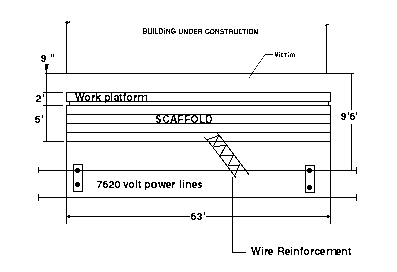20-Year-Old Bricklayer Electrocuted in Maryland
FACE 87-19
Introduction
The National Institute for Occupational Safety and Health (NIOSH), Division of Safety Research (DSR) is currently conducting the Fatal Accident Circumstances and Epidemiology (FACE) Project, which is focusing primarily upon selected electrical-related and confined space-related fatalities. The purpose of the FACE program is to identify and rank factors that influence the risk of fatal injuries for selected employees.
On November 24, 1986, employees were working from a tubular welded frame scaffold to construct a brick wall. A ten foot section of wire reinforcement being moved by a co-worker contacted a 7620 volt power line and the scaffold. When this occurred, a bricklayer, who was in contact with the metal railing of the scaffold, was electrocuted.
Contacts/Activities
Officials of the Occupational Safety and Health Program for the State of Maryland notified DSR concerning this fatality and requested technical assistance. This case has been included in the FACE Project. On January 13, 1987, the DSR research team coordinator conducted a site visit, collected incident data, photographed the site, interviewed comparison workers, and discussed the incident with the state compliance officer and the employer representative.
Overview of Employer’s Safety Program
The employer is a small masonry company which employed 50 workers at the time of the incident. Because the work is seasonal the number of employees fluctuates accordingly.
The company does not have a formal safety program and does not have any safety rules which address working on scaffolds.
Synopsis of Events
On November 24, 1986, seven employees of a masonry company were working from a tubular welded frame scaffold to build a brick wall for a building under construction. The scaffold was 9 sections long; one section wide; and 4 sections high (approximately 63 feet x 5 feet x 24 feet). The scaffold planking was constructed of wood. A work platform was attached to the front of the scaffold facing the brick wall. This platform was 2 feet wide and ran the length of the scaffold. The platform was 22 feet above the ground. The bricklayers worked while standing on this platform and received their stock from the main part of the scaffold. The scaffold was located between a 7620 volt power line and the building under construction (see Figure 1). The horizontal distance from the power line to the edge of the scaffold was 21 inches. The height of the power line from ground level was 27 ½ feet.
At the time of the accident, a laborer was walking along the top section of the scaffold carrying a piece of wire reinforcement (10 feet long and 8 inches wide). The wire reinforcement touched the 7620 volt line. The laborer, who was wearing leather gloves at the time, received a shock and dropped the wire reinforcement. The reinforcement fell across the 7620 volt line and the metal rail of the scaffold, energizing the entire scaffold. A bricklayer (the victim) was standing on the work platform, but was in contact with the main scaffold. This contact provided a path to ground and the bricklayer was electrocuted. Burn marks on the victim’s hands and left leg above the knee indicate that he was touching the frame of the main scaffold with his hands while his knee touched the frame of the work platform section. The wire reinforcement eventually fell from the 7620 volt line, de-energizing the scaffold.
Emergency medical service (EMS) personnel arrived in approximately ten minutes and administered advance cardiac life support. Attempts to resuscitate the victim were unsuccessful. The victim was pronounced dead on arrival at a nearby hospital. None of the other workers on the scaffold received injuries.
Cause of Death
Cause of death was listed as electrocution. Burn marks were on the victim’s hands and left leg above the knee.
Recommendations/Discussion
Recommendation #1: The employer should not erect scaffolds within ten feet of energized electrical power lines.
Discussion: Although there are no Federal regulations concerning working a specified distance from energized power lines, several states have requirements concerning this activity. Erection of the scaffold within 21 inches of the power line was inherently dangerous and should not have been permitted.
Recommendation #2: The electrical power lines should have been de-energized.
Discussion: The brick wall being constructed was nine feet, six inches horizontally from the power lines. According to the power company, this met their minimum requirement concerning distance between the power lines and buildings. Unfortunately, when the scaffold was constructed in this area, a safe distance from the power lines could not be maintained. The power lines should have been de-energized. In this instance, the lines serviced only one existing building, and there would have been minimal disruption of service.
Recommendation #3: The employer should develop a safety program designed to recognize and correct hazards.
Discussion: The company does not provide training in safe work procedures and does not have any safety rules which address working on scaffolds. The tasks performed by workers while on the scaffolds should be evaluated, hazards identified, and these hazards should be addressed by a safety program.
Recommendation #4: Hazard awareness regarding overhead powerlines should be stressed and routinely reviewed so that all employees working near overhead power lines are aware of these energized sources.
Discussion: The danger of overhead powerlines appears to be obvious; however, contact with powerlines and the subsequent occupationally-related fatalities continue. Employers must stress and routinely review the hazards associated with overhead powerlines. The workers were not aware of the hazards associated with working near energized powerlines. Prior to the incident, an electrician told the workers on the scaffold that the 7620 volt line “might be hot.” In an apparent attempt to see if he indeed would get shocked, an 18-year-old worker reached from the scaffold and touched the 7620 volt line. Fortunately for him, he was standing on the wood planks of the scaffold and did not provide a path to ground.

Figure 1. Top View of Fatality Site
